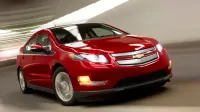CARB rules the Chevy Volt is a ULEV, emits more* than Prius or Jetta TDI

How clean is the Chevrolet Volt? According to the California Air Resources Board (CARB), the Volt is a ULEV (PDF link), an ultra low emissions vehicle. This means that the Volt – in this one specific way of calculating things – is dirtier than cars like the Toyota Prius, Honda Insight and Honda CR-Z.
How does CARB do the math for this? The full details are in this PDF, but the gist is that there are two tests CARB uses (known as the Supplemental Federal Test Procedures): a high-speed, high-acceleration test (US06) and the SC03 air-conditioner test. Emissions are measured and the results determine the vehicle’s status (see a list of levels after the jump). The Volt did well in most categories, but not concerning carbon monoxide. CO limits for SULEV status is 1.0 grams per mile, while ULEV is 2.1 g/mi. Volt produces 1.3 g/mi.
The trick is that these tests need to be done with an engine running. Since the Volt doesn’t need to burn any gasoline to move, under many circumstances – and the Volt engineers even needed to develop a maintenance mode to deal with the new problem of aging gas in the tank – the Volt is a special beast and, probably to GM’s dismay, it doesn’t benefit from its battery-only ability in this test. CARB’s LEV III ruleset proposal would include a way to include these vehicles in the categories.
Still, the Volt will burn gasoline, and now we can compare it to other vehicles that do so. Informational charts are available after the jump and there’s more over at Prius Chat. Thanks to usbseawolf2000 for the tip and the chart!
[Source: CARB, Prius Chat]






